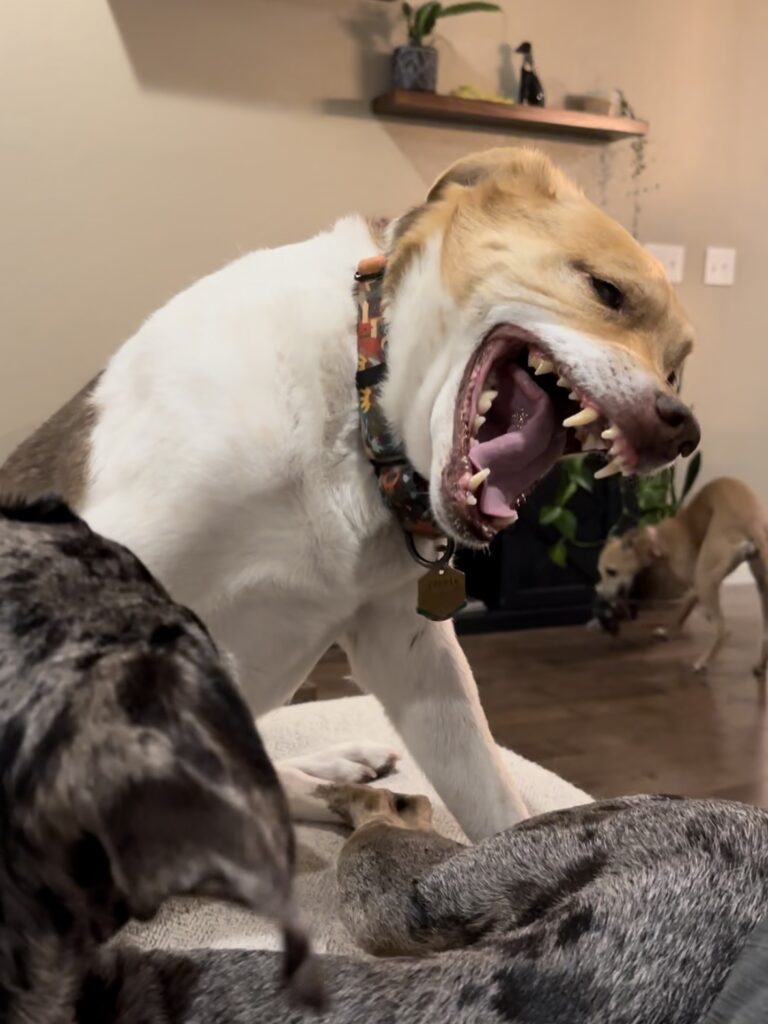Cheryl Warner, MSc CAB, KPA CTP, CBCC-KA
Shelter Animal Training & Behavior Manager
National Dog Bite Prevention Week occurs every year in April, and we want to share some information and tips to keep you and your family safe! While dog bites are scary, there is so much you can do to prevent them – and it’s mostly about understanding your dog and how they’re communicating with you.
Tip #1 – Understand why dog bites happen
In many cases, dog bites are not the result of an animal being inherently “aggressive.” Instead, bites frequently happen when a dog is just trying to get space in an uncomfortable situation. Most dogs will try other strategies first, such as backing away, barking and growling to show that they need some space. Bites are usually a last resort when everything else hasn’t worked.
Important Note: Never punish a dog for growling (or doing any other behavior that shows they are uncomfortable). It is important that dogs be able to communicate when they are stressed so that you can help them get out of the situation before they feel the need to bite. Punishing a dog for communicating when they are uncomfortable only increases the likelihood that they will just go straight to biting when they are uncomfortable in the future (without giving you other warning signs first). Punishing growling is like taking the timer off a ticking time bomb!
Tip #2 – Learn about your dog’s body language
To prevent dog bites, you need to understand how dogs are trying to communicate with you. A dog’s primary language is body language! A great way to start becoming fluent in your dog’s language is by taking HSBV’s free online Dog Body Language course.

Common body language signals your dog may show to communicate they’re uncomfortable and need space (from humans or dogs) include:
- Licking their lips (when they’re not eating or begging for something tasty)
- Pinning their ears back
- Looking away or turning their head away
- Showing you the whites of their eyes
- Lowering their body or tucking their tail
Check out this dog body language gallery, then watch your dog this week to see how many subtle signs you can identify. Better yet, get the whole family involved!
Tip #3 – Help your dog get space when they need it
Now that you know which signs to watch for that might indicate that your dog wants space in a situation, you can also give them a helping hand so that they can move away without needing to growl, snap or bite.
- Ask people to give your dog space if you notice subtle signs of discomfort around people or dogs. You can always just say, “My dog is in training and needs a little space, can you please step back a bit?”
- Use treats to lead your dog away. Put a few tasty treats in between your thumb and forefinger, let them sniff, then slowly move away so they follow you.
- If your dog is showing discomfort in response to you, perhaps during a nail trim, ear cleaning or some other interaction, stop what you’re doing and take a break, ideally until the next day. When you start again, offer lots of treats to make sure they’re willing to engage with you, and take breaks when you notice any subtle signs of discomfort or stress.
Tip #4 – Always supervise children around dogs
This includes when children are around the family dog! Children often move and make noises in ways that can make dogs feel uncomfortable or stressed. It only takes a few seconds for an unsupervised child to end up in a risky situation with a dog, for example by cornering the dog, pulling on the dog’s ears or tail, taking a chew away from a dog, trying to ride the dog, etc. Children are also less likely to see and know how to interpret dog body language, which means the dog’s warning signals are more likely to be missed. Given all these factors, it’s no surprise that children are the victims in more than half of all dog bite incidents! Supervision and education can go a long way in keeping children safe around their furry friends.
Check out these resources from Family Paws for more information on how to keep children and dogs safe together.
Tip #5 – Train your dog to wear a muzzle comfortably
In some situations, a dog may not be able to get space when they need it, such as during a vet visit where critical care is needed. You can protect your dog and other people by training your dog to comfortably wear a muzzle in these situations. While there is still some stigma in our society regarding muzzles, they’re a great tool for helping keep everyone safe. It’s important that you work on muzzle training before your dog ends up in a situation where they need to wear one. In fact, start this training during puppyhood!
Check out these resources from the Muzzle Up! Project on how to muzzle train your dog.
If we all learn to speak a little more “dog,” we can keep ourselves, our families, our pets, and our communities safer!
